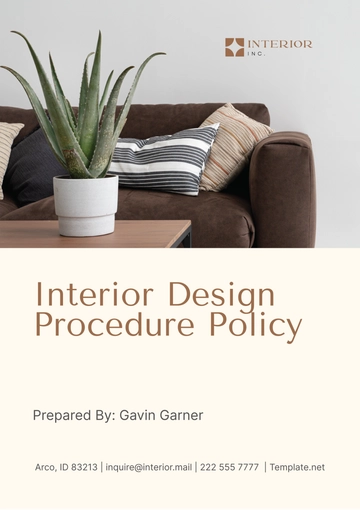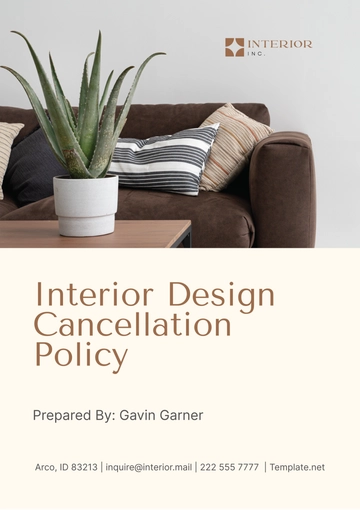Free Interior Design Training Policy

I. Introduction
A. Purpose
[Your Company Name] acknowledges the significance of cultivating a highly skilled and knowledgeable team of interior designers. The purpose of this Interior Design Training Policy is to establish guidelines and procedures for the training and development of interior designers within our organization, ensuring that they possess the requisite expertise to deliver exceptional design solutions.
B. Scope
This policy applies to all interior designers employed by [Your Company Name], irrespective of their tenure or level within the organization. It encompasses all aspects of training, including curriculum development, delivery methods, assessment, and compliance.
C. Objectives
To equip interior designers with comprehensive skills and knowledge in interior design theory, principles, and practices.
To foster a culture of continuous learning and professional development among interior designers.
To uphold industry standards, regulations, and ethical principles in all design endeavors undertaken by [Your Company Name].
II. Training Program Overview
A. Training Needs Assessment
[Your Company Name] conducts regular assessments to identify the specific training needs of interior designers. These assessments may include surveys, performance evaluations, and consultation with team leaders and project managers.
B. Training Curriculum
The training curriculum is meticulously crafted to cover a wide range of topics essential for interior design excellence. The following table outlines the core components of the curriculum:
Module | Description |
|---|---|
Design Principles | Fundamentals of design theory and aesthetics |
Space Planning | Techniques for efficient utilization of space |
Color Theory | Understanding color psychology and application |
Material Selection | Evaluation and selection of materials |
Building Codes | Familiarization with relevant codes and regulations |
Sustainability | Integration of sustainable practices in design |
Additionally, specialized modules may be offered based on emerging trends, client requirements, or industry developments.
III. Training Implementation
A. Training Enrollment
Interior designers are required to enroll in mandatory training sessions as per the training calendar. Enrollment is facilitated through the HR department, and all designers are notified in advance of upcoming training opportunities. Upon enrollment, designers receive detailed information regarding the training objectives, schedule, and expectations.
B. Attendance and Participation
Interior designers must attend all training sessions as scheduled unless excused for valid reasons approved by their immediate supervisor or the training coordinator. Attendance is recorded for each session to ensure compliance.
Active participation in training activities, such as discussions, workshops, and hands-on exercises, is expected from all attendees. Designers are encouraged to engage with trainers and fellow participants to maximize learning outcomes.
C. Evaluation and Feedback
Regular evaluations are conducted to assess the effectiveness of training sessions and the overall training program. Evaluation criteria may include content relevance, training methods, instructor effectiveness, and participant engagement.
Feedback from participants is solicited after each training session to gather insights on the quality of content, delivery methods, and areas for improvement. Feedback mechanisms may include surveys, focus group discussions, or one-on-one interviews with trainers.
IV. Training Evaluation and Monitoring
A. Performance Metrics
[Your Company Name] establishes key performance indicators (KPIs) to measure the impact of training on interior designers' performance. These metrics may include:
Client satisfaction ratings for completed projects
Project completion timelines compared to estimates
Compliance with design standards and regulations
Number of design revisions requested by clients or stakeholders
Performance data is regularly collected and analyzed to track improvements attributable to training interventions. Trends and patterns are identified to inform future training priorities.
B. Monitoring and Reporting
A designated training coordinator, appointed by [Your Company Name], is responsible for monitoring the progress of interior designers through training programs. The coordinator tracks attendance, participation, and performance metrics for each designer.
The training coordinator generates comprehensive reports on training attendance, completion rates, performance metrics, and feedback summaries. These reports are presented to management and stakeholders on a regular basis to provide transparency and accountability.
C. Continuous Improvement
[Your Company Name] values continuous improvement and actively seeks ways to enhance the effectiveness of its training program. Feedback from training evaluations, performance metrics, and industry developments is carefully reviewed.
Regular review meetings are conducted to discuss findings, identify areas for improvement, and implement necessary changes to the training curriculum and delivery methods. Trainers and subject matter experts are involved in the review process to ensure alignment with industry best practices and emerging trends.
V. Compliance and Documentation
A. Regulatory Compliance
[Your Company Name] is committed to ensuring that all training programs adhere to relevant laws, regulations, and industry standards governing the interior design profession. This includes compliance with:
Local building codes and regulations
Occupational health and safety standards
Ethical guidelines set forth by professional associations
The training curriculum is periodically reviewed and updated to reflect any changes in regulations or industry best practices.
B. Documentation
Comprehensive documentation of training activities is maintained to demonstrate compliance and facilitate ongoing improvement. This documentation includes:
Records of training sessions, including dates, topics covered, and attendance records
Participant feedback and evaluation forms
Certificates of completion or achievement for each training module
Any relevant legal or regulatory documentation related to training requirements
All documentation is stored securely and accessible to authorized personnel for audit and compliance purposes.
VI. Training Program Review
A. Periodic Review
[Your Company Name] conducts regular reviews of the training program to assess its relevance, effectiveness, and alignment with organizational goals. These reviews are typically conducted on an annual basis but may occur more frequently as needed.
B. Revision and Updates
Based on the findings of the review process, necessary revisions and updates are made to the training curriculum, delivery methods, and evaluation processes. This ensures that the training program remains current and responsive to the evolving needs of interior designers and the industry.
C. Stakeholder Involvement
Stakeholders, including interior designers, management, HR personnel, and clients, are actively involved in the review process. Their input and feedback are solicited to identify areas for improvement and ensure that the training program continues to meet the needs of all stakeholders.
D. Implementation of Changes
Upon approval of proposed changes, [Your Company Name] implements them promptly and communicates updates to all relevant parties. This may include announcing revised training schedules, providing updated training materials, or conducting additional training sessions to address new requirements or opportunities for improvement.
VII. Conclusion
[Your Company Name] is committed to providing ongoing training and development opportunities to its interior designers to foster professional growth and ensure excellence in design services. Through a comprehensive training program that covers essential design principles, practical skills, and regulatory compliance, we aim to empower our designers to deliver innovative, high-quality solutions that exceed client expectations.
By continually reviewing and updating our training curriculum, incorporating feedback from participants and stakeholders, and staying abreast of industry trends, [Your Company Name] remains at the forefront of the interior design profession. We recognize that investing in the continuous learning and development of our team not only benefits our designers individually but also enhances the overall reputation and success of our organization in the [industry].
As we move forward, [Your Company Name] remains dedicated to upholding the highest standards of professionalism, creativity, and integrity in all aspects of our work. We will continue to prioritize the growth and development of our interior designers, ensuring that they are equipped with the knowledge, skills, and support they need to thrive in their roles and make meaningful contributions to our projects and clients.
- 100% Customizable, free editor
- Access 1 Million+ Templates, photo’s & graphics
- Download or share as a template
- Click and replace photos, graphics, text, backgrounds
- Resize, crop, AI write & more
- Access advanced editor
Invest in employee development with Template.net's Interior Design Training Policy Template. This customizable document provides clear guidelines and procedures for implementing training initiatives to enhance the skills and knowledge of interior design staff. Ensure a culture of continuous learning and improvement. Editable in our Ai Editor Tool for seamless customization to reflect your interior design training policies and objectives.
You may also like
- HR Policy
- Restaurant Policy
- Company Policy
- Accounting Policies and Procedures
- Website Policy
- Privacy Policy
- Safety Policy
- School Policy
- IT and Software Policy
- Law Firm Policy
- Construction Policy
- Interior Design Policy
- Travel Agency Policy
- Education Academic Policy
- Security Policy
- Real Estate Policy
- Expense Policy
- Software Policy






















